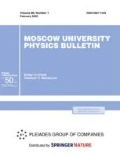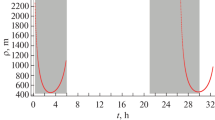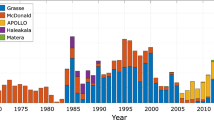Abstract
It is shown that due to the relativistic transformation law of angles, a laser pulse reflected from a moving retroreflector propagates not strictly back, but at a small angle to the direction of the laser station. For this reason, the ray located on the periphery of a pulse reaches the receiving telescope of the laser station instead of the central ray of a pulse. As a result, the flux of electromagnetic energy received by the laser station is certainly less than the flux of energy in the vicinity of the central ray. The energy flux attenuation coefficient is assessed on the basis of numerical analysis. It is shown that if the receiving telescope is separated from the laser station in order to be mobile and is moving along the Earth’s surface so that the center of each spot formed by a pulse of the reflected light hits the telescope, then the electromagnetic energy flux during laser probing of the satellite will be higher by more than 100 times in comparison with the energy flux received by the stationary telescope of the laser station. From our study it follows that the maximum speed of motion of the centers of spots on the Earth’s surface does not exceed 8 km/h.
Similar content being viewed by others
References
V. V. Batygin and I. N. Toptygin, Problem Book in Electrodynamics (Nauka, Moscow, 1970).
N. Ashby and B. Bertotti, Phys. Rev. 34, 2246 (1986).
M. M. Denisov, Elektromagn. Volny Elektron. Sist. 15, 33 (2010).
Yu. L. Kokurin, Quantum Electron. 33, 45 (2003).
J. Degnan, presented at ILRS Technical Laser Workshop “Satellite, Lunar and Planetary Laser Ranging: Characterizing the Space Segment,” Frascatti, 2012.
V. I. Denisov, B. N. Shvilkin, V. A. Sokolov, and M. I. Vasili’ev, Phys. Rev. D 94, 045021 (2016).
A. Einstein, Collected Works (Moscow, 1965), Vol. 1.
L. D. Landau and E. M. Lifshitz, Hydrodynamics (Nauka, Moscow, 1988).
V. A. Fock, Theory of Space, Time, and Gravity (Gos. Izd. Fiz.-Mat. Lit., Moscow, 1961).
L. E. El’sgol’ts, Differential Equations and Variational Calculus (Nauka, Moscow, 1965).
V. I. Denisov, V. A. Sokolov, and M. I. Vasiliev, Phys. Rev. D 90, 02301 (2014).
V. I. Denisov, I. P. Denisova, and S. I. Svertilov, Theor. Math. Phys. 135, 720 (2003).
M. M. Denisov, Astron. Rep. 51, 512 (2007).
M. M. Denisov, N. V. Kravtsov, and I. V. Krivchenkov, JETP Lett. 85, 412 (2007).
M. M. Denisov and A. A. Zubrilo, Moscow Univ. Phys. Bull. 64, 569 (2009). doi 10.3103/S0027134909060022
V. I. Denisov and M. M. Denisov, Comput. Math. Math. Phys. 48, 1418 (2008).
M. V. Ostanina, M. A. Pasisnichenko, and V. S. Rostovskii, Moscow Univ. Phys. Bull. 68, 478 (2013). doi 10.3103/S0027134913060106
V. L. Denisov and S. I. Svertilov, Phys. Rev. D 71, 063002 (2005).
G. N. Duboshin, Celestial Mechanics (Moscow, 1968).
M. M. Denisov, Meas. Tech. 52, 1167 (2009).
http://www.npk-spp.ru.
http://ilrs.gsfc.nasa.gov.
Author information
Authors and Affiliations
Corresponding author
Additional information
Original Russian Text © I.V. Mazaeva, M.A. Pasisnichenko, 2017, published in Vestnik Moskovskogo Universiteta, Seriya 3: Fizika, Astronomiya, 2017, No. 4, pp. 60–67.
About this article
Cite this article
Mazaeva, I.V., Pasisnichenko, M.A. The effect of the relativistic transformation law of angles on laser ranging of satellites moving in circular orbits equipped with a single retroreflector. Moscow Univ. Phys. 72, 402–409 (2017). https://doi.org/10.3103/S0027134917040087
Received:
Accepted:
Published:
Issue Date:
DOI: https://doi.org/10.3103/S0027134917040087




